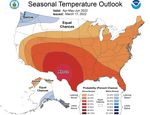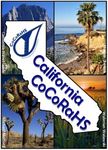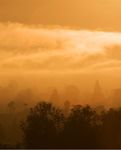CALIFORNIA CUMULONIMBUS - COCORAHS
←
→
Page content transcription
If your browser does not render page correctly, please read the page content below
Page 1
California
Cumulonimbus
Spring 2022
March Madness 2022
by Samantha Connolly
CoCoRaHS March Madness is in full swing, and continues through the end of
March. During CoCoRaHS March Madness, states try to win the CoCoRaHS
cup by recruiting the most new observers in their state during the month of
March each year.
As of March 26, Minnesota is crushing the competition with 342 volunteer
sign-ups in March so far. They hold the top spot in the per capita count as
well.
Articles in this Edition:
March Madness 1
2022
Observer 2
Spotlight: Climate
Normals
Drought Conditions 3
in California
Mar/Apr/May 2022 4
Outlook
Contributors & 5
CoCoRaHS
Background
California has recruited 4 new volunteers so far in March, and hopefully
we can get some more before the month ends! Spread the word about
CoCoRaHS to your friends and family, and have them sign up at:
https://www.cocorahs.org/Content.aspx?page=applicationPage 2
California Cumulonimbus
Observer Spotlight: Climate Normals
by Matthew Kidwell
Every ten years the National Centers for Environmental Information (NCEI) publishes climate nor-
mals based on data from the last 30 years. Normals are essentially averages of the data, but with quali-
ty control done to account for any missing data or data irregularities.
For the first time, some of the CoCoRaHS observers with the most complete and longest records have
been included in these normals. The longest running CoCoRaHS stations in California only date back
to the year 2000, therefore no CoCoRaHS stations will be included in the traditional 30 year normals.
However, there are also two additional categories where normals are created with less than 30 years of
data. First, there are Provisional Normals which require stations to have 10 years of daily rainfall
(including zeros on days with no rain) on every day of the year 10 times. Twenty-eight stations in Cali-
fornia met this criteria with four of those stations in northwest California, thirteen in central California,
and eleven in southern California. Here is a listing of all the CoCoRaHS stations that have been in-
cluded in these normals:
Northwest CA: McKinleyville 2.7 SE, McKinleyville 2.3 NE, Br idgeville 5.2 ENE, and Ukiah
8.4 NW.
Central California: Soda Spr ings 1.5 SSW, Placer ville 3.7 SW, Davis 0.8 NE, Car michael 0.9
NE, Linden 5.8 ENE, Glen Ellen 1.5 N, Sebastopol 4.5 WSW, Martinez 0.8 SSE, Pacifica 0.3 W,
Foster City 1.3 SW, Sunnyvale 1.9 SE, Walnut Creek 1.4 SSE, Inyokern 9.4 WSW.
Southern California: Glendale 2.4 WSW, Whittier 2.9 WSW, J oshua Tr ee 2.0 S, Cor ona 12.8
SE, Mission Viejo 1.3 SSE, Oceanside 8.4 NE, San Marcos 2.5 ENE, Encinitas 2.7 N, San Diego
Country Estates 1.5 WNW, Poway 3.2 NE, El Cajon 1.5 WSW.
A big thank you to these observers for their diligence and attention to
detail!
Additionally, there are Pseudo-Normals, which only have monthly normals. A station qualifying for
“Pseudo-normal” status must have each calendar month complete with daily observations in at least
two years. This can include a limited number of Multi-day reports if they remain in the same month.
This means that observers who report regularly but have only been observing for a few years can qual-
ify. For more details and a list of all the CoCoRaHS stations and their normals visit: https://
www.cocorahs.org/Content.aspx?page=climate-normalsPage 3
California Cumulonimbus
Drought Conditions in California
by Samantha Connolly
D rought conditions have worsened across California over the last month, with the entire state in
some level of drought as the weather turned mostly dry for the start of 2022. Most recently, the Extreme
Drought category (D3) has expanded across much of northwestern California, the Central Valley, and
portions of southeast California. The majority of the state (56 percent) remains in Severe Drought (D2).
Many of the areas in the Severe and Extreme Drought categories have experienced record dryness since
the start of 2022. Groundwater, soil moisture, and snow water equivalent (SWE) are all below-normal
and nearby reservoir levels are, on average, 50 percent of their historical averages as we begin transi-
tioning into a drier time of year.
The persistent high pressure that we’ve had in California this month has finally weakened, and the
“storm door” has opened for a late March storm to bring beneficial rains to parts of California. We will
take what we can get, given we are towards the tail end of California’s wet season.California Cumulonimbus
April/May/June 2022 Outlook
By Samantha Connolly
The 3 month outlook for April/May/June
2022 was released on March 17th by the
Climate Prediction Center (CPC). The
CPC is currently leaning slightly towards
above normal temperatures in central and
southern California, and equal chances of
above, near, or below normal for northern
California. Much of the contiguous U.S is
leaning towards above normal tempera-
tures for the next 3 months.
This temperature outlook highly favors the
currently active La Niña conditions in the
equatorial Pacific. La Niña is favored to
continue into the Northern Hemisphere
summer with generally equal odds for ei-
ther La Niña or ENSO-neutral thereafter at
about 40-50% likelihood.
For the seasonal precipitation outlook,
it is also split for California, with a
slight tilt towards below normal in
northern and parts of central Califor-
nia, and equal chances of above, near
or below normal in southern Califor-
nia.
While California is beginning to tran-
sition out of the wet season, storms in
April and May can happen. Storms
that occur in April and May are gener-
ally less strong than in Jan/Feb/Mar,
but the rainfall these storms provide
can help bump up our rainfall totals
ahead of the dry summer and fall sea-
sons.
Page 4Page 5
California Cumulonimbus
Spring 2022 California Cumulonimbus Contributors
Samantha Connolly, California Regional Coordinator, South Coast San Diego Region: Contr ibuting Author and Editor
NWS San Diego
Matthew Kidwell, California Regional Coordinator, Northwest California Region: Contr ibuting Author
NWS Eureka
What is CoCoRaHS?
CoCoRaHS, which stands for Community Collaborative Rain Hail and Snow Network, is a non-profit group of volunteer
precipitation observers. Anyone can join, and it's easy to report the information. All you need is a 4 inch rain gauge, the
internet, and a few minutes each day. The website is easy to navigate and has different instructional materials for anyone to
learn how to record an observation.
The site also has daily maps of observer’s reports showing where precipitation fell the day before. It's fun to compare the
different amounts of precipitation that can fall in an area from just one storm. Not only is the information interesting to look
at, it is very valuable for organizations such as the National Weather Service, hydrologists, farmers and many others.
Visit cocorahs.org to sign up. Join CoCoRaHS, today!
Rain gauge
required for
the program.
cocorahs.org California CoCoRaHS State Webpage California CoCoRaHS weather.gov
Do you have any ideas or suggestions of future topics that you would like to see covered in this
newsletter? If so, simply send an email to Sam at samantha.connolly@noaa.gov!You can also read



























































